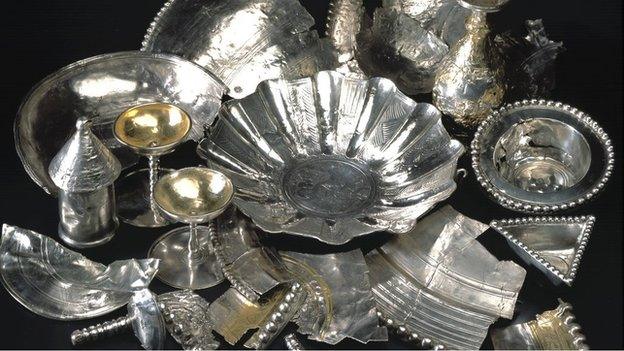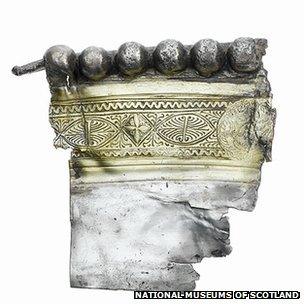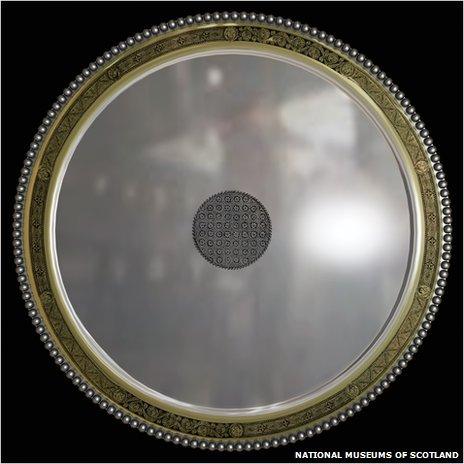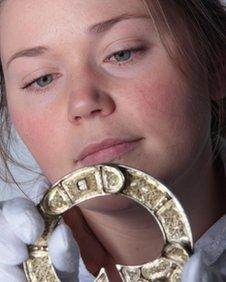What would chopped up Traprain Law Roman silver have looked like?
- Published

The largest hoard of "hacked up" Roman silver ever found was discovered on a hill east of Edinburgh almost 100 years ago.
Now experts have taken a fresh look at two of the small fragments in the treasure and think they were from one of the biggest silver dishes in the whole of the Roman world. Why was valuable and ornate Roman silverware cut into small pieces and what would it have looked like if it had not been?
It is thought the hoard of Roman silver from Traprain Law in East Lothian was buried more than 1,500 years ago, at the beginning of the Early Medieval period - or, as it used to be referred to, the Dark Ages.

Two fragments from the rim of a plate were used in the recreation
This is the period when, after 400 years of occupation, the Roman empire receded from Britain.
Of course, the land now called Scotland was never truly part of that massive empire but, at various times during the previous centuries, it had been under Roman control.
Dr Fraser Hunter, principal curator of the Iron Age and Roman collections at the National Museum of Scotland, says: "At the date the hoard is buried in the 5th Century, Scotland is definitely outside the Roman empire and it is the largest silver hoard from beyond the edge of the empire.
"It is also the largest 'hacked up' hoard anywhere. There is no larger hoard known. So, of its kind, it is the biggest and the best."
The hoard, which was discovered in 1919, was at first assumed to have been acquired by the barbarians of Traprain as "loot".
Dr Hunter says: "This was thought to be our barbaric ancestors descending on the soft underbelly of the Roman empire, looting and pillaging the treasure and then bringing it back here to what was called the Pirates Nest at Traprain, where it was hacked to pieces because they were barbarians."
He says this always seemed a slightly odd explanation because the people at Traprain were on good terms with the Romans for several hundred years.
The museum has been looking at other hacksilver across Europe and reinterpreting the Traprain find.
It is now believed that, rather than being about barbarians who did not appreciate the beauty of an intricately patterned dinner plate, it was more likely to have been a response to economic crisis.
"You find it inside the Roman empire as well," says Dr Hunter. "At times of economic crisis, people stopped trusting other forms of currency and they turned to silver and gold.
"Suddenly, all the pretty twiddly bits no longer mattered. What mattered is the sheer weight of metal, so the bullion value becomes much more important than whether it is a fine cup or a plate or a dish."
Dr Hunter says it is also striking that many of the fragments are cut up into sizes that correlate with Roman weight standards.

The recreation of the dish has revealed it to be among the most prestigious silverware in the Roman empire
He says this is "not random destruction", it is done by people who have contact with the Roman world.
"The most likely explanation is that the hacking is actually done inside the empire and the silver is moved to Traprain Law, perhaps as a diplomatic gift, perhaps as payment for mercenary services or something like that," Dr Hunter says.
The Traprain Law treasure includes about 250 items and weighs about 22kg.
Among the pieces are two "quite small fragments" of a silver dish, says Alice Blackwell, the research officer behind a project to reconstruct one of the hoard's platters.
The National Museums of Scotland project, funded by whisky firm Glenmorangie, used laser scanning technology to recreate what it would have looked like.
Ms Blackwell believes the dish, which would have measured 70cm (28in) in diameter, was "up there among the most important and prestigious and largest pieces of tableware anywhere from within the whole Roman empire".

Alice Blackwell says the treasure contains "exquisite" pieces
"From these two surviving fragments, we now know for sure it is among the best silver from the empire," she says.
Silver tableware in the Roman empire was used to show people how important the owner was, explains Ms Blackwell.
"It is not functional silver platters and things, this is a very prestigious showcasing display of power. These are deliberately power symbols. They would have been used by the most important members of society."
The reconstructed design is based on small areas of surviving decoration on the original silver fragments. None of the middle portion of this dish has survived and so the central engraved medallion is taken from a very similar dish found in Switzerland.
"The recreation of this one dish helps us to get a better sense of the importance of the hoard as a whole and helps to re-emphasise that Traprain contains some exquisite pieces of late Roman silver, " Ms Blackwell says. "Some incredibly high-quality pieces."
She says the hacking is part of why the treasure is such an interesting and valuable find.
And she suggests her project to recreate the dish has a fitting symmetry.
"We are taking two small fragments and making a whole from them," she says.
"But the process has happened for real in reverse - it was a whole plate that was taken and fragmented up."